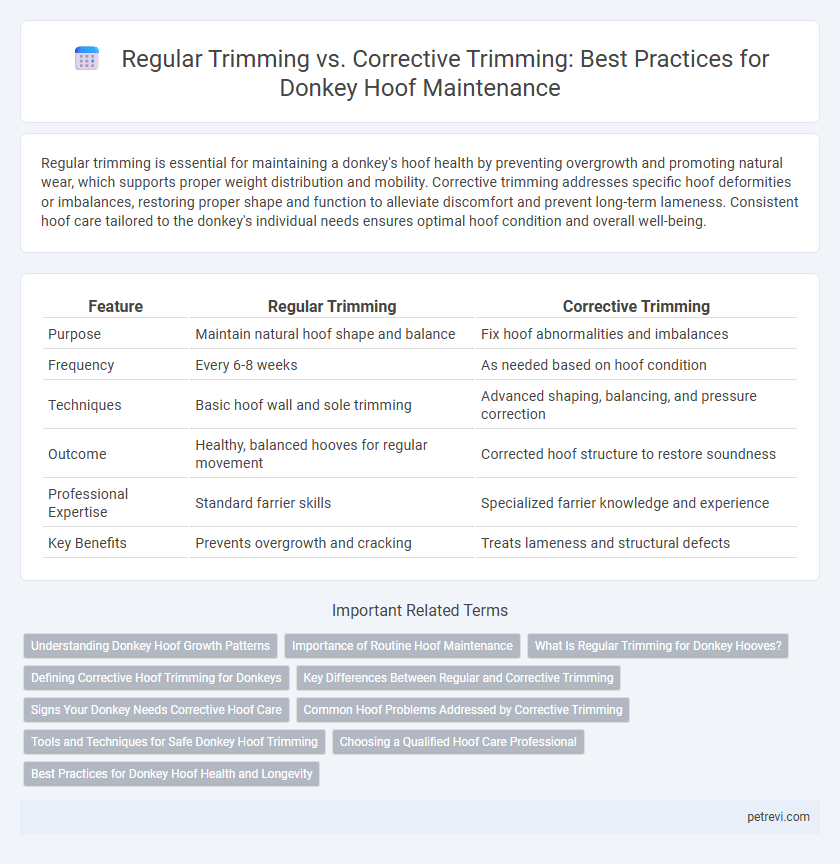Regular trimming is essential for maintaining a donkey's hoof health by preventing overgrowth and promoting natural wear, which supports proper weight distribution and mobility. Corrective trimming addresses specific hoof deformities or imbalances, restoring proper shape and function to alleviate discomfort and prevent long-term lameness. Consistent hoof care tailored to the donkey's individual needs ensures optimal hoof condition and overall well-being.
Table of Comparison
| Feature | Regular Trimming | Corrective Trimming |
|---|---|---|
| Purpose | Maintain natural hoof shape and balance | Fix hoof abnormalities and imbalances |
| Frequency | Every 6-8 weeks | As needed based on hoof condition |
| Techniques | Basic hoof wall and sole trimming | Advanced shaping, balancing, and pressure correction |
| Outcome | Healthy, balanced hooves for regular movement | Corrected hoof structure to restore soundness |
| Professional Expertise | Standard farrier skills | Specialized farrier knowledge and experience |
| Key Benefits | Prevents overgrowth and cracking | Treats lameness and structural defects |
Understanding Donkey Hoof Growth Patterns
Regular trimming maintains the natural shape of donkey hooves by addressing consistent growth patterns, preventing overgrowth and discomfort. Corrective trimming targets uneven or abnormal hoof growth caused by injury, disease, or poor conformation, restoring balance and functionality. Understanding the unique hoof growth rate and wear patterns specific to donkeys is essential for effective maintenance and optimal hoof health.
Importance of Routine Hoof Maintenance
Routine hoof maintenance is crucial for donkeys to prevent lameness and ensure overall health, with regular trimming maintaining proper hoof shape and balance essential for weight distribution. Corrective trimming addresses specific hoof deformities or imbalances, aiding in the prevention of long-term structural damage. Neglecting regular and corrective trimming can lead to severe hoof problems, impacting mobility and well-being.
What Is Regular Trimming for Donkey Hooves?
Regular trimming for donkey hooves involves routine cutting and shaping to maintain proper hoof balance and prevent overgrowth, typically scheduled every 6 to 8 weeks. This consistent maintenance supports healthy hoof structure, encourages natural wear patterns, and helps avoid common issues like cracking or uneven weight distribution. Proper regular trimming ensures donkeys remain comfortable and reduces the risk of lameness or other hoof-related complications.
Defining Corrective Hoof Trimming for Donkeys
Corrective hoof trimming for donkeys involves targeted adjustments to address hoof deformities, imbalances, or chronic conditions that affect mobility and overall hoof health. Unlike regular trimming, which maintains normal hoof shape and length, corrective trimming requires expert assessment to realign the hoof structure and redistribute weight properly. This specialized approach is essential for preventing lameness and promoting recovery in donkeys with abnormal hoof growth or injury-related issues.
Key Differences Between Regular and Corrective Trimming
Regular trimming maintains a donkey's hoof by removing overgrown areas to support natural shape and prevent cracking, typically performed every 6 to 8 weeks. Corrective trimming addresses abnormal hoof conditions such as imbalances, hoof wall separations, or deformities, requiring specialized techniques to restore proper alignment and function. The key difference lies in the purpose: regular trimming preserves routine hoof health, while corrective trimming focuses on resolving specific structural issues.
Signs Your Donkey Needs Corrective Hoof Care
Visible signs your donkey requires corrective hoof care include uneven hoof growth, cracks, and signs of lameness or discomfort during movement. Regular trimming maintains natural hoof shape, but corrective trimming addresses abnormalities caused by injuries, infections, or chronic neglect. Early detection of symptoms like heat in the hoof, foul odor, or excessive sole pressure can prevent severe complications and improve overall hoof health.
Common Hoof Problems Addressed by Corrective Trimming
Corrective trimming in donkey hoof maintenance effectively addresses common hoof problems such as overgrown hooves, hoof cracks, and imbalances caused by improper wear or injury. It realigns the hoof structure to promote even weight distribution, preventing lameness and further deterioration of the hoof wall. Regular trimming maintains hoof health, but corrective trimming specifically targets and resolves structural abnormalities to restore optimal hoof function.
Tools and Techniques for Safe Donkey Hoof Trimming
Effective donkey hoof maintenance requires selecting appropriate tools such as hoof knives, nippers, and rasps designed for the unique toughness of donkey hooves. Regular trimming focuses on maintaining natural hoof shape with gentle techniques to prevent overgrowth, while corrective trimming involves precise trimming angles correcting deformities or uneven wear. Safe hoof trimming emphasizes restraint methods and gradual trimming to avoid injury, promoting overall hoof health and mobility.
Choosing a Qualified Hoof Care Professional
Selecting a qualified hoof care professional is crucial for effective donkey hoof maintenance, ensuring both regular trimming and corrective trimming are performed safely. Proper expertise helps prevent common hoof problems such as cracks, overgrowth, and infections by tailoring care to the donkey's specific hoof condition. Certified farriers or equine podiatrists with experience in donkey anatomy provide the best outcomes for long-term hoof health and mobility.
Best Practices for Donkey Hoof Health and Longevity
Regular trimming of donkey hooves ensures balanced weight distribution and prevents common issues such as overgrowth and cracking, promoting overall hoof health. Corrective trimming addresses structural abnormalities or imbalances, restoring proper hoof alignment and preventing long-term lameness or discomfort. Consistent hoof maintenance every 6 to 8 weeks, tailored to the donkey's environment and activity level, is essential for optimal hoof longevity and mobility.
Regular Trimming vs Corrective Trimming for Donkey Hoof Maintenance Infographic

 petrevi.com
petrevi.com